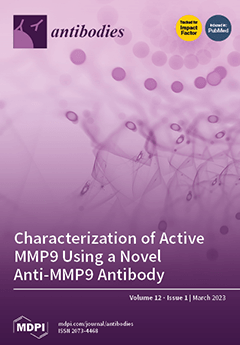C-C chemokine receptor 9 (CCR9) is a receptor for C-C-chemokine ligand 25 (CCL25). CCR9 is crucial in the chemotaxis of immune cells and inflammatory responses. Moreover, CCR9 is highly expressed in tumors, including several solid tumors and T-cell acute lymphoblastic leukemia. Several preclinical
[...] Read more.
C-C chemokine receptor 9 (CCR9) is a receptor for C-C-chemokine ligand 25 (CCL25). CCR9 is crucial in the chemotaxis of immune cells and inflammatory responses. Moreover, CCR9 is highly expressed in tumors, including several solid tumors and T-cell acute lymphoblastic leukemia. Several preclinical studies have shown that anti-CCR9 monoclonal antibodies (mAbs) exert antitumor activity. Therefore, CCR9 is an attractive target for tumor therapy. In this study, we conducted the epitope mapping of an anti-mouse CCR9 (mCCR9) mAb, C
9Mab-24 (rat IgG
2a, kappa), using the 1× alanine (1× Ala)- and 2× alanine (2× Ala)-substitution methods via enzyme-linked immunosorbent assay. We first performed the 1× Ala-substitution method using one alanine-substituted peptides of the mCCR9 N-terminus (amino acids 1–19). C
9Mab-24 did not recognize two peptides (F14A and F17A), indicating that Phe14 and Phe17 are critical for C
9Mab-24-binding to mCCR9. Furthermore, we conducted the 2× Ala-substitution method using two consecutive alanine-substituted peptides of the mCCR9 N-terminus, and showed that C
9Mab-24 did not react with four peptides (M13A–F14A, F14A–D15A, D16A–F17A, and F17A–S18A), indicating that
13-MFDDFS
-18 is involved in C
9Mab-24-binding to mCCR9. Overall, combining, the 1× Ala- or 2× Ala-scanning methods could be useful for understanding for target–antibody interaction.
Full article






